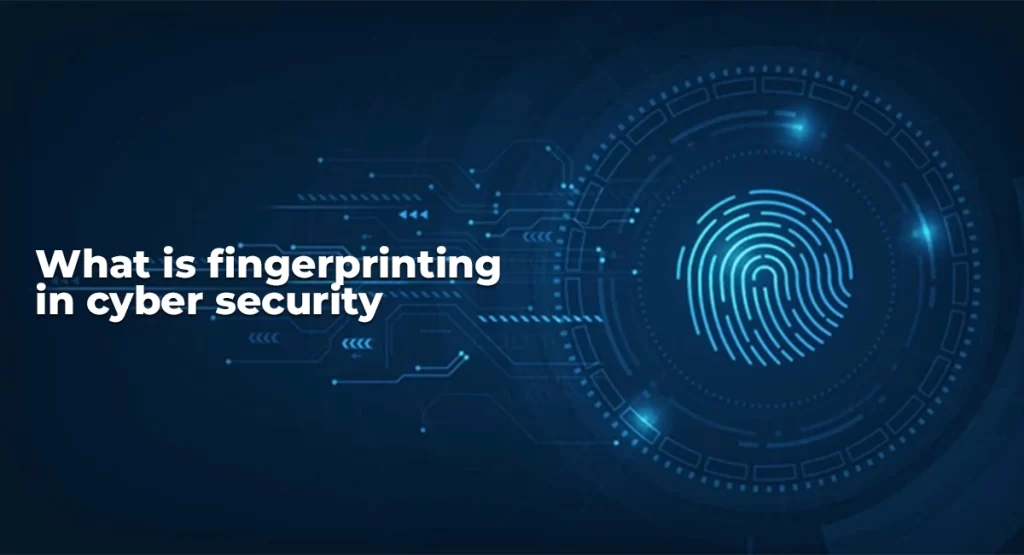In today’s digital world, cybersecurity is more important than ever for keeping our information safe from cyber threats. One key part of cybersecurity is something called fingerprinting. It’s a way to identify and categorize devices, networks, or people based on their unique features. Let’s take a closer look at what fingerprinting is, why it’s important, and how it’s used in cybersecurity.
What is Fingerprinting?
In the world of cybersecurity, fingerprinting refers to the process of gathering information about a device, network, or user to create a unique identifier or “fingerprint.” This fingerprint serves as a digital signature that distinguishes one entity from another based on specific attributes or characteristics. These attributes can include hardware configurations, software versions, network protocols, system settings, and more.
The Significance of Fingerprinting in Cybersecurity
Fingerprinting plays a important role in cybersecurity for several reasons:
1. Identification and Authentication:
By analyzing unique characteristics, fingerprinting allows systems to identify and authenticate devices, networks, or users. This helps ensure that only authorized entities gain access to sensitive resources or information.
2. Vulnerability Assessment:
Fingerprinting can reveal valuable insights into the security posture of a system or network. By identifying software versions, system configurations, and potential vulnerabilities, cybersecurity professionals can assess the risk level and take appropriate measures to mitigate threats.
3. Intrusion Detection:
Fingerprinting techniques are often used in intrusion detection systems (IDS) to monitor network traffic and detect suspicious activity. By comparing network traffic patterns against known fingerprints of malicious behavior, IDS can identify and respond to potential cyber threats in real-time.
4. Forensic Analysis:
In the event of a cybersecurity incident, such as a data breach or cyberattack, fingerprinting can be instrumental in forensic analysis. By analyzing digital fingerprints left behind by attackers, cybersecurity experts can reconstruct the sequence of events, identify the source of the attack, and gather evidence for investigative purposes.
Types of Fingerprinting
Fingerprinting techniques can be broadly categorized into two main types: active and passive fingerprinting.
- Active Fingerprinting: It involves sending specific queries to a target device and analyzing responses, like port scanning or OS fingerprinting. It’s detailed but can trigger alerts.
- Passive Fingerprinting: This method observes network traffic without direct interaction, like packet sniffing or behavior monitoring. It’s less intrusive but provides less detail.
Applications of Fingerprinting in cyber security
Fingerprinting has numerous applications across various domains of cybersecurity:

Network Security
Fingerprinting is very important for network security as it helps identify and monitor connected devices. By creating unique fingerprints for each device, administrators can spot unauthorized or unusual activity and respond accordingly. It also aids in identifying outdated software, allowing for timely updates to prevent security threats.
Control Cyber Threats
Fingerprinting is key to spotting and understanding cyber threats by pinpointing their distinct features or behaviors. By matching these fingerprints with known threat patterns, potential dangers in network activity or device actions can be spotted and dealt with. These techniques aid in spotting malware, intrusion tries, or unauthorized access, empowering organizations to safeguard their systems and networks effectively.
Web application security
When it comes to securing web applications, fingerprinting methods play a vital role in spotting vulnerabilities. By checking HTTP traffic and scrutinizing different parts of web apps, fingerprinting helps uncover any weaknesses or setup errors that attackers could exploit. This insight guides the implementation of security measures or fixes to prevent possible attacks.
Anti- spam & fraud measures
In the fight against spam and fraud, fingerprinting helps identify suspicious patterns or traits linked to malicious behavior. For instance, browser or device fingerprinting can spot and stop harmful bots or fraudulent transactions. By using fingerprinting methods, companies can strengthen their defenses against spam and fraud, safeguarding their users or customers.
Forensic Investigation
Fingerprinting is essential in forensics, offering digital evidence to reconstruct cyber incidents, pinpoint culprits, and aid legal actions. It helps investigators piece together what happened, who was involved, and gather proof for court cases, enhancing cybersecurity efforts and ensuring justice in digital realms.
Implications of Fingerprinting
- Fingerprinting assists in device and user identification, enhancing cybersecurity measures for authentication and threat detection.
- Privacy issues arise as fingerprinting can collect sensitive data without consent, potentially infringing on user privacy rights.
- Stringent security measures are necessary to prevent cyber attackers from exploiting fingerprinting for targeted attacks, alongside ensuring regulatory compliance to avoid legal repercussions.
FAQ
1. What is Fingerprinting in Cybersecurity?
Fingerprinting is the process of identifying and categorizing devices, networks, or individuals based on unique characteristics like hardware configurations and software versions.
2. Why is Fingerprinting Important?
Fingerprinting aids in identification, authentication, vulnerability assessment, intrusion detection, and forensic analysis, enhancing cybersecurity measures and protecting against threats.
3. What are the Types of Fingerprinting?
Fingerprinting techniques include active (e.g., port scanning) and passive (e.g., packet sniffing), each offering unique advantages and considerations for cybersecurity.
4. What are the Applications of Fingerprinting?
Fingerprinting is used for network security, threat detection, web application security, anti-spam measures, and forensic investigations, highlighting its diverse applications in cybersecurity.
Conclusion
In conclusion, fingerprinting plays a vital role in cybersecurity by enabling identification, authentication, vulnerability assessment, intrusion detection, and forensic analysis. While fingerprinting offers significant benefits

